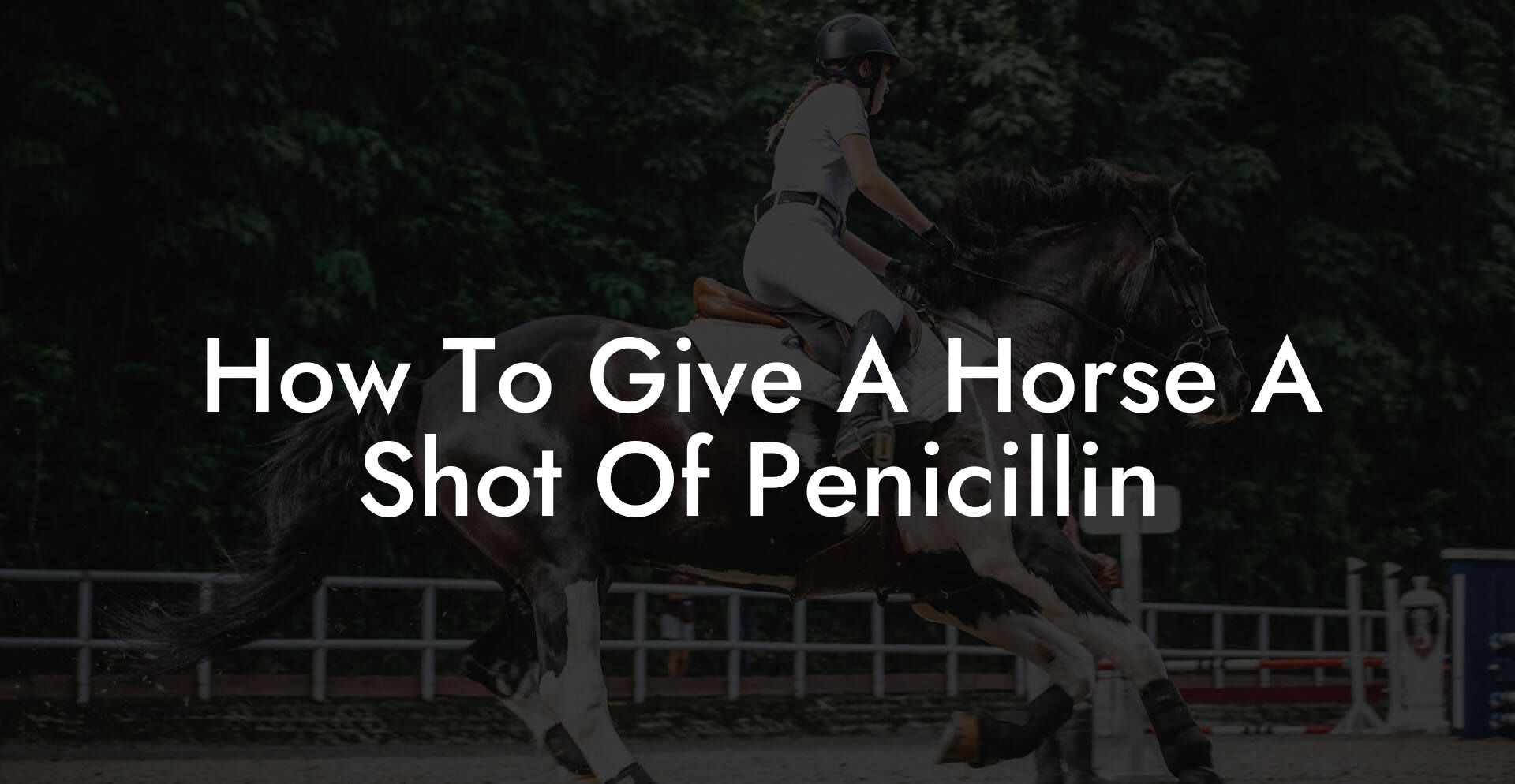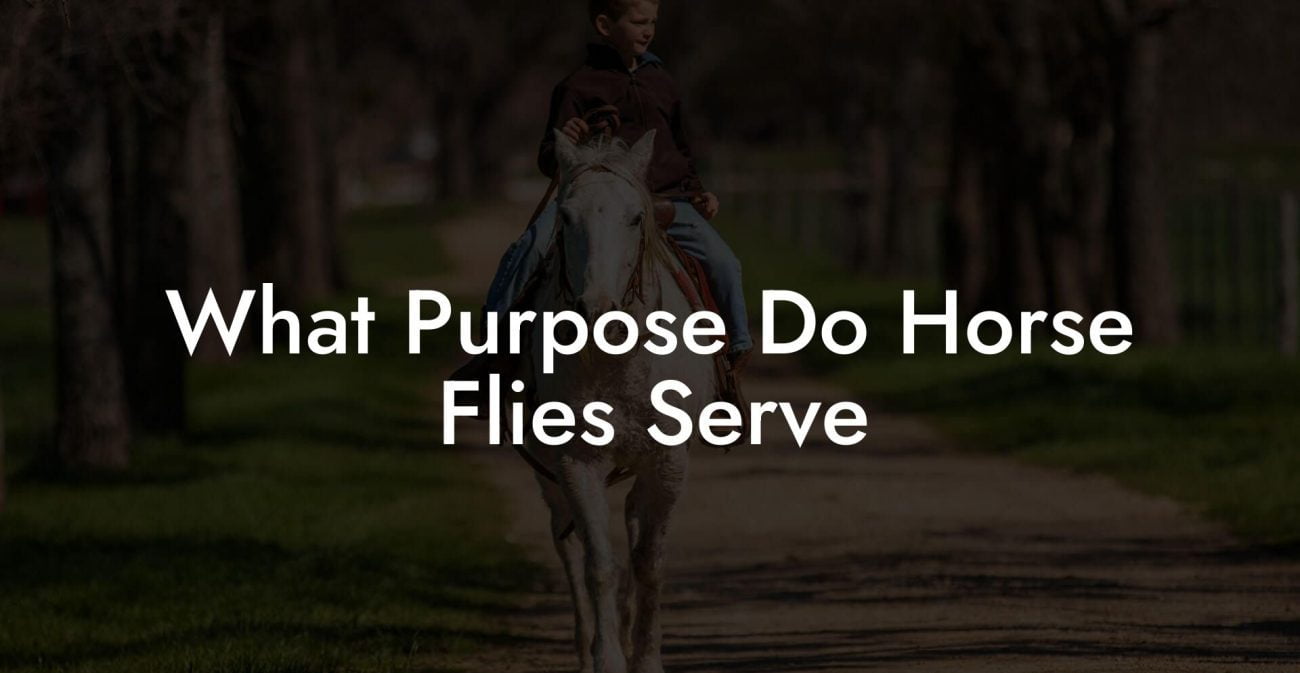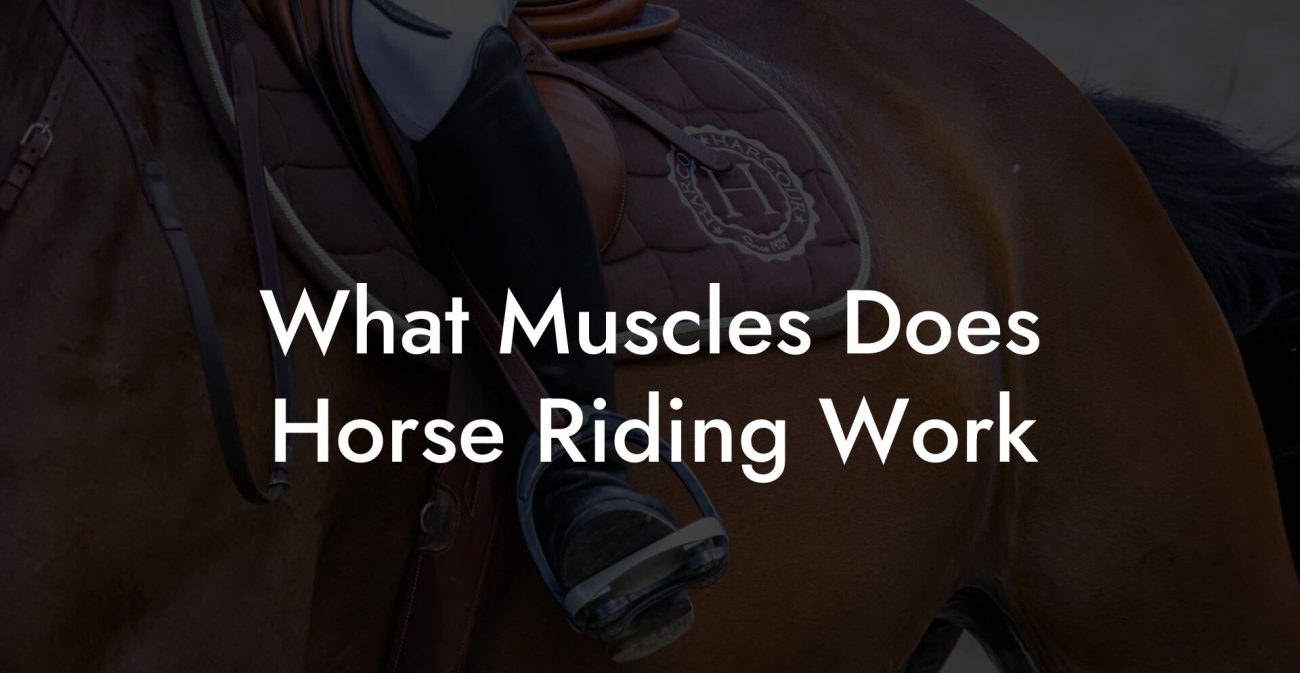Buckle up, because we're about to gallop through the unexpectedly fun and surprisingly meticulous world of equine care, specifically, how to give a horse a shot of penicillin! This isn't your average how-to guide; it's a lighthearted yet in-depth exploration into the art and science of administering this life-saving antibiotic for our four-legged friends. Whether you're a dedicated horse parent, an aspiring equine caregiver, or simply someone who finds the very idea of a needle and a neigh oh-so intriguing, you're in for a wild ride. Today, we’ll cover everything from why your horse might need penicillin to all the nitty-gritty details of preparation, injection technique, and post-shot care. So saddle up and let’s dive headlong into the world of equine health care with a twist of humor and a whole lot of heart!
Quick Links to Useful Sections
- Understanding Why Your Horse Might Need Penicillin
- Veterinary Consultation: Your First Gallop Toward Safe Care
- Preparing for the Shot: equipment, Environment, and Essential Safety
- Step-by-Step: How to Give a Horse a Shot of Penicillin
- Step 1: Ensure a Calm, Alert Mindset (for Both You and Your Horse)
- Step 2: Verify the Equipment and Medication
- Step 3: Prepare the Injection Site
- Step 4: Restrain Your Horse Safely
- Step 5: Administer the Injection
- Step 6: Dispose of the Used Equipment Safely
- Step 7: Check on Your Horse
- Post-Shot Care and Monitoring: Keeping Your Horse Happy and Healthy
- Common Mistakes and How to Avoid Them
- Rushing the Process
- Improper Injection Site Preparation
- Incorrect Needle Angle and Depth
- Overlooking Aspiration
- Neglecting Post-Injection Monitoring
- Resources and Community Support: Your Next Steps
- Frequently Asked Questions About Giving a Horse a Shot of Penicillin
- Your Path to Confident, Informed Equine Care
Understanding Why Your Horse Might Need Penicillin
Penicillin, a powerful antibiotic that has saved lives for decades, is sometimes the drug of choice for tackling bacterial infections in horses. When a horse comes down with issues such as abscesses, respiratory infections, or even certain skin conditions, penicillin might be administered to stave off the spread of harmful bacteria. Now, before you picture a horse lined up at a pharmacy, let’s get one thing straight: the decision to give your unruly equine a shot of penicillin should always be made in consultation with a licensed veterinarian.
In the horse care universe, penicillin is revered for its effectiveness against a host of bacterial infections. That said, the dosage, administration technique, and overall health of the horse are critical factors to consider. Not all horses will react the same way to an injection, and a one-size-fits-all approach can be hazardous. It’s not just about knowing the how-to, but also understanding the why behind every meticulous step. After all, our noble steeds deserve the best, and getting the dosage right can mean the difference between a swift recovery and a potential complication.
The world of equine medicine is filled with technical jargon and medical protocols, but here’s the straightforward truth: when a horse needs penicillin, it’s usually because a bacterial infection is putting its well-being at risk. Penicillin works its microbial magic by interfering with the bacteria’s cell wall synthesis, effectively halting their growth and giving the horse’s immune system the upper hand. Remember, though, that while penicillin is a trusty sidekick, it’s not a cure-all. There are times when alternative treatments, dietary supplements, and integrated care approaches are also on the menu.
To sum it up, penicillin can be a life-saver when a horse battles a bacterial infection, but it’s not a decision to be taken lightly. Our equine chums may be the kings and queens of the pasture, but their health needs proper vet oversight, timely diagnosis, and careful administration of any medication, especially injections.
Veterinary Consultation: Your First Gallop Toward Safe Care
Before you even think about grabbing that syringe, it’s essential to understand that administering a penicillin shot is not a casual DIY project. Consulting with a veterinarian is absolutely crucial. A licensed vet will perform a thorough physical exam to confirm that the infection is indeed bacterial and that penicillin is the appropriate remedy.
Vets can help determine the correct dosage based on factors like the horse’s weight, overall health, and the severity of the infection. They also have the know-how to spot any underlying conditions that could complicate the treatment process. Sometimes, a horse might have an allergic reaction or require a different class of antibiotics entirely. So, think of your veterinarian as your equine co-pilot: their expertise ensures that you’re not navigating dangerous territory alone.
While the internet is an excellent resource for research, nothing replaces the personalized guidance of a trained professional. Even if you’re keen on learning all the drill-by-drill details of administering a penicillin shot, remember that your vet is the final arbiter. And hey, learning how to work with a vet doesn’t just boost your credibility, it also makes you an even more responsible and informed horse caregiver.
Preparing for the Shot: equipment, Environment, and Essential Safety
Preparation is the key to a successful penicillin injection. Remember, a calm environment and all your gear in order can make the process smoother for both you and your horse. Let’s break down what you’ll need:
- Sterile Equipment: You’ll require a new needle and syringe (or prefilled penicillin vial) every time. Sterilize all your equipment to prevent any risk of contamination and further infection.
- Proper Dosage: Always have the prescribed dosage on hand as given by your veterinarian. Overdose or underdose can both cause serious issues.
- Disinfectants: Clean the injection site, and your hands, with an appropriate antiseptic solution. Safety and hygiene are non-negotiable.
- Restraint Tools: Depending on your horse’s temperament, you might need halters, ropes, or even a chute. The goal here is to minimize movement and stress so that the injection can be administered accurately.
- Comfort Items: Sometimes, a favorite treat or a calming companion (another horse or a caring human) can help ease the tension. A stress-free horse is a cooperative horse!
Next, set up a quiet, safe space where your horse feels secure. Think of it as arranging a VIP lounge for your equine superstar. Remove any potential hazards, ensure the area is clean, and double-check that you have everything in place before you even think about opening that penicillin vial.
If you’re a first-timer or even if you consider yourself relatively experienced, a dry run is always beneficial. Walk through the steps, check your supplies, and mentally rehearse each stage of the process. Not only does this help build confidence, but it also minimizes risks when it’s time to give the actual shot.
Step-by-Step: How to Give a Horse a Shot of Penicillin
Now comes the moment of truth: the actual act of injecting penicillin into your horse. This isn’t a procedure to be taken lightly, but with the right preparation and care, you can execute it like a pro. We’ve broken down the process into detailed steps, blending technical know-how with a dash of humor to keep things lively.
Step 1: Ensure a Calm, Alert Mindset (for Both You and Your Horse)
The first step is grounding yourself and your brilliant equine companion. If you’re jittery, your horse will feel it, which might cause unnecessary stress. Take a few deep breaths, remind yourself that you’ve done your research, and get ready to channel your inner equine whisperer. Sometimes, even a soothing playlist or a few encouraging pet words can work wonders.
Step 2: Verify the Equipment and Medication
Lay out all your tools on a sanitized tray. Here’s your checklist once more:
- New, sterile syringe (or prefilled syringe) with the correct dosage of penicillin.
- New needle (never reuse needles, safety first!).
- Alcohol swabs and antiseptic solution.
- Appropriate restraint equipment (halters, ropes, etc.).
- A waste disposal container for used needles.
Double-check that the penicillin is the correct formulation and that you know whether it needs to be warmed to room temperature for optimal absorption. This might sound trivial, but in the world of veterinary medicine, these small details can make a big difference in efficacy.
Step 3: Prepare the Injection Site
Identify the proper injection site. Ideally, for penicillin, the injection is given into the neck muscle or the gluteal area, depending on veterinary direction. Use an alcohol swab to cleanse the area meticulously. A well-prepped injection site minimizes the risk of introducing bacteria and reduces the discomfort for your horse.
For the uninitiated, imagine this step as giving your horse a mini spa treatment, except instead of a massage, it’s a quick antiseptic wipe. Keeping the area clean is paramount to ensure that the penicillin works its magic without any unwanted complications.
Step 4: Restrain Your Horse Safely
No one enjoys a wild ride, especially your horse, when it’s time for an injection. Proper restraint helps prevent sudden movements that could lead to injury. Use a halter or a chute to secure your horse in a calm and controlled manner. If your horse is known to be a bit skittish, enlist a helper to hold it steady. Safety for both you and your horse is the name of the game.
Communication is key during this step. Talk gently to your horse, reassuring it that everything is going fine. A confident, reassuring tone can help set the stage for a smooth injection.
Step 5: Administer the Injection
Now comes the critical moment: the injection itself. Follow these steps carefully:
- Needle Insertion: Hold the syringe like a pro, firm but gentle. With a swift, confident motion, insert the needle into the muscle at the prepped injection site. Ensure the needle is at the correct angle, usually about 45 degrees from the skin surface, unless otherwise specified by your vet.
- Aspiration: Before injecting the penicillin, pull back slightly on the plunger. This technique (called aspiration) checks for blood infusion, which would indicate that you've accidentally hit a blood vessel. If you see blood, withdraw and select a new spot.
- Injecting the Penicillin: Once you’ve confirmed the needle is correctly positioned (no blood in the syringe), slowly depress the plunger to administer the full dose of penicillin. Do so in a calm, steady motion, ensuring the medication disperses evenly into the muscle tissue.
- Withdrawing the Needle: After the medication is fully injected, extract the needle smoothly and apply some light pressure on the site with a clean swab. This helps reduce the chance of any minor bleeding and soothes the spot.
Performing these steps in a controlled, unhurried manner is the hallmark of a job well done. Visualize it as a delicate art form where precision meets compassion, because every pet deserves the best care possible.
Step 6: Dispose of the Used Equipment Safely
Once the injection is complete, immediately dispose of the used needle and syringe in a puncture-proof sharps container. Do not leave used needles lying around, remember, safety protocols aren’t just for your horse, but for your entire stable environment.
Confirm that all waste is properly handled and that your work area is cleaned up thoroughly. A clean environment helps maintain the overall health of your horse and prevents any accidental injuries or infections.
Step 7: Check on Your Horse
Last but not least, give your horse some post-injection love. Monitor its behavior and look for any signs of adverse reactions, such as swelling, discomfort, or an allergic reaction. Even if your equine buddy is generally resilient, keeping an eye on it for a few hours after the injection ensures that any issues are caught early.
And there you have it, a complete run-through of how to give a horse a shot of penicillin. The process might seem intimidating at first, but with a clear head, proper equipment, and guidance from a trusted vet, you’ll soon master the technique. Remember: patience, precision, and a dash of humor go a long way in turning a potentially nerve-wracking experience into a successful health intervention.
Post-Shot Care and Monitoring: Keeping Your Horse Happy and Healthy
After you’ve administered the penicillin shot, the work isn’t quite over. Post-shot care is an essential phase that can make all the difference in ensuring your horse recovers quickly and completely. The following guidelines will help you monitor your horse’s progress:
Observation: Keep a close eye on your horse for the next 24 to 48 hours. While most horses tolerate the injection well, look out for any unusual behavior, such as reluctance to move, decreased appetite, or signs of discomfort. A slight soreness at the injection site is normal, but any severe swelling or prolonged pain should be reported to your vet immediately.
Comfort Measures: After the injection, your horse might benefit from additional care. Provide a quiet, stress-free environment with plenty of fresh water and high-quality feed. If your horse seems a bit off, a gentle massage or a warm compress on the injection site (as recommended by your vet) can work wonders.
Follow-Up with Your Vet: Schedule a follow-up consultation to discuss how your horse is responding to the treatment. Your vet might advise a recheck or additional doses if the infection is particularly stubborn. Keeping your vet in the loop ensures that any complications are caught early.
Documentation: Maintain a simple log detailing your horse’s behavior and any observations worth noting after the injection. This record will be helpful for future consultations and can provide valuable insights into how your horse responds to treatment.
Post-shot care is all about creating a secure routine that reinforces recovery and minimizes stress. Treat your horse like the star it is, a little extra TLC can go a long way in ensuring a smooth and successful recuperation.
Common Mistakes and How to Avoid Them
Even the most seasoned equine caretaker can sometimes stumble when it comes to giving a horse a shot of penicillin. Learning from common pitfalls is key to ensuring that both you and your horse have a positive experience. Here are some mistakes to watch out for:
Rushing the Process
Haste makes waste (and sometimes a sore horse)! Rushing through the procedure can lead to mistakes like improper restraint or skipping vital safety checks. Always take your time to double-check your equipment, secure your horse, and verify the dosage.
Improper Injection Site Preparation
Failing to adequately cleanse the injection site can invite bacteria into the wound, leading to complications. Make sure you disinfect the area thoroughly with alcohol swabs before administering the shot.
Incorrect Needle Angle and Depth
Missing the ideal injection angle can mean the medication doesn’t reach the intended muscle tissue, reducing its effectiveness and potentially causing discomfort. Follow your veterinarian’s instructions regarding the angle (typically around 45 degrees) and the depth needed to ensure proper dispersal.
Overlooking Aspiration
Skipping the aspiration phase might result in accidentally hitting a blood vessel. Always pull back the plunger slightly before injecting to ensure you’re in the right spot. If blood appears, reposition and try again.
Neglecting Post-Injection Monitoring
Once the shot is given, it’s vital not to breeze past the post-care phase. Keep an eye on your horse for any signs of adverse reactions. Prompt action at the first sign of trouble can prevent minor issues from becoming major concerns.
By taking note of these common mistakes and actively working to avoid them, you can significantly boost the success rate of administering a penicillin shot to your horse. Remember, attention to detail and a cautious approach are your best friends in achieving a safe and effective treatment.
Resources and Community Support: Your Next Steps
Navigating the complexities of equine care, especially when it comes to administering injections, isn’t something you have to do alone. Connecting with a community of like-minded horse enthusiasts, veterinarians, and equine care experts can provide ongoing support and inspiration. Here are some essential resources and next steps to ensure you’re continually learning and growing as a horse caregiver:
Join Equine Health Forums: There are plenty of online communities where horse owners share their personal experiences and tips on various topics, from dietary adjustments to handling injections. These forums can be a goldmine of real-life stories, troubleshooting advice, and step-by-step guides that have been tried and tested by other horse enthusiasts.
Follow Reputable Veterinary Blogs and Social Media Channels: Many veterinarians and animal care experts share insights, instructional videos, and updates on the latest research in equine health care. Subscribing to these channels not only keeps you informed but also connects you with a broader network of professionals.
Attend Workshops and Webinars: Look for local or online workshops that focus on equine first aid, managing bacterial infections, and administering injections. Interactive sessions with experts can offer hands-on training and answer any lingering questions you might have.
Consult Trusted Veterinarians Regularly: Building a long-term relationship with a local veterinary practice ensures you have a reliable resource to turn to whenever questions arise or if you need a refresher on techniques. Your veterinarian can provide personalized advice that aligns with the unique needs of your horse.
Invest in Quality Equipment: Having the right supplies on hand, from sterile needles to well-maintained restraint gear, can make all the difference in the care you provide. Keep your equipment organized and replace items as needed to stay on top of your horse’s health game.
Finally, remember that taking care of a horse goes beyond medical procedures, it’s about nurturing a bond based on trust, mutual respect, and continuous learning. Whether you're a newbie or a seasoned equine aficionado, engaging with a supportive community can provide both emotional boost and practical tips for enhancing your horse care skills.
As you continue your journey, keep exploring new methods, stay updated with veterinary research, and don’t hesitate to ask questions. Your commitment to your horse’s well-being is not just an action, it’s a statement of love and responsibility. So, connect, share, and grow with fellow horse lovers, and let your horse thrive with every thoughtful, expert-approved step you take.
Frequently Asked Questions About Giving a Horse a Shot of Penicillin
We know that administering a penicillin injection to a horse can raise plenty of questions. Here are some of the most frequently asked questions to guide you along the way:
1. When is it necessary to give a horse penicillin?
Penicillin is typically administered when a horse is suffering from bacterial infections, such as abscesses, respiratory ailments, or certain skin infections. However, the decision should always be made by a qualified veterinarian based on a thorough diagnosis.
2. How do I know the correct dosage for my horse?
The correct dosage depends on factors like the horse’s weight, overall health, and severity of the infection. Always follow your veterinarian’s prescription and recommendations for the proper dosage.
3. What if my horse moves during the injection?
Movement during the injection can be challenging. That’s why proper restraint using halters, ropes, and, if necessary, the assistance of a helper is essential for ensuring safety and accuracy.
4. Is there any risk of allergic reactions?
Although horses generally tolerate penicillin well, there is a risk of allergic reactions. Always monitor your horse closely after the injection, and consult your veterinarian immediately if you notice signs of swelling, hives, or difficulty breathing.
5. How important is site preparation for the injection?
Extremely important! Cleaning and disinfecting the injection site reduces the risk of introducing bacteria, ensures the medication is properly absorbed, and minimizes discomfort for your horse.
6. Why is aspiration recommended before injecting the medication?
Aspiration checks to see if the needle has inadvertently entered a blood vessel. A small pull on the plunger should be performed before full injection, if blood appears, reposition the needle to avoid complications.
7. What should I do if I notice adverse effects after the injection?
Any adverse symptoms such as severe swelling, prolonged discomfort, or lethargy should be reported to your veterinarian immediately. Post-injection monitoring is crucial to promptly address any issues.
8. Can I administer penicillin at home regularly?
Regular administration should only be done under the guidance and prescription of your veterinarian. Overuse or improper administration of antibiotics can lead to resistance or additional health complications.
9. Is it safe to reuse needles if they’re still sharp?
Absolutely not. To avoid any risk of infection or cross-contamination, always use a fresh, sterile needle for each injection.
10. How do I dispose of used needles and syringes?
Used needles and syringes should always be placed in a puncture-proof sharps container immediately after use. Follow your local guidelines for medical waste disposal.
Your Path to Confident, Informed Equine Care
Mastering the art of administering a penicillin shot to your horse isn’t just about sticking a needle in a muscle, it’s a journey that intertwines responsibility, precision, and compassion towards our beloved equine companions. Every step, from vet consultation and meticulous preparation to the actual procedure and post-shot care, is a testament to the dedication you bring to equine health.
By following the guidelines outlined here and connecting with a supportive community of horse enthusiasts and professionals, you can ensure that your horse receives the best possible care in a safe, effective, and compassionate manner. Remember, thoughtful preparation and adherence to proper techniques are the pillars of successful administration. Patience, attention to detail, and a willingness to learn are the tools that will lead you to confident, informed equine care.
As you continue to educate yourself, embrace the nuances of equine health, and build relationships with veterinary experts, you become not only a better caregiver but also an advocate for the welfare of these majestic animals. Your journey is one of continuous learning and unyielding dedication, an adventure filled with surprising challenges, heartwarming success stories, and plenty of opportunities to share laughs along the way.
So, step into your role as a well-informed equine caretaker with both caution and joy, knowing that each carefully given shot, every measured dose, and all the extra efforts you make ultimately lead to a healthier, happier horse. The road to excellence in equine healthcare is long, winding, and filled with new lessons at every turn, embrace it with confidence, humility, and that signature spirit that makes you a true guardian of these magnificent creatures.













